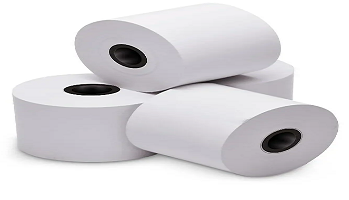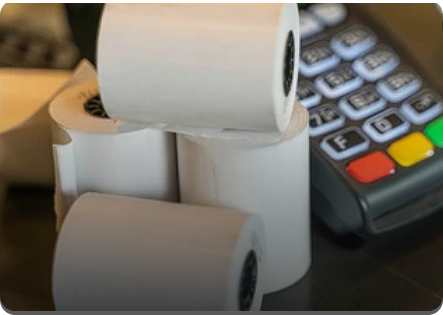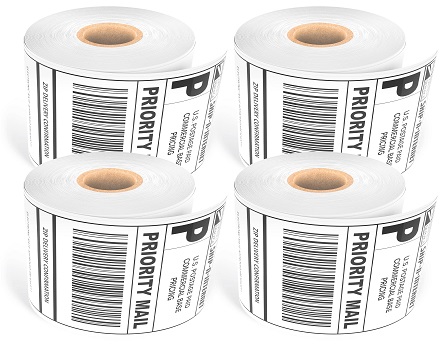What is thermal paper?
Thermal paper comes in a variety of different types and sizes. Thermal paper rolls are the most common type used for printing receipts, tickets, labels, and other documents with thermal printers.
Thermal paper rolls come in various sizes and shapes to fit different types of printers, such as point-of-sale (POS) systems and mobile receipt printers. Thermal printing transfers heat from a thermal print head to the special coating on the paper. This heat activates the chemicals in the thermal paper, which then turn black and form an image. Thermal printing is used for various applications, from labels to tickets and receipts. Thermal printers are also popular because they’re faster, more reliable, and more cost-effective than other printing styles.

Thermal printing is a process that uses heat instead of ink or toner to print an image. Thermal paper and thermal printer paper rolls are used in the process, which contains chemicals that react to heat, resulting in text or custom printed thermal receipt paper rolls printed. Thermal paper and thermal printer paper rolls come in different sizes and thicknesses depending on the type of application. First, the paper is coated with a layer of heat-sensitive dye.
When thermal printing occurs, heat from the printer’s print head is applied to the kiosk paper roll manufacturer, activating the dye and creating an image or text. Thermal paper is often used in retail applications such as POS (Point of Sale) systems, cash registers, and gas station pumps, where speed and ease of use are important. It is also used in medical imaging devices such as x-rays, MRIs, and ultrasounds. Thermal paper is also used in digital printing applications such as ATMs, ticketing systems, and kiosks.
How does thermal paper roll different from regular paper?
As we mentioned earlier, thermal paper is a special paper with a heat-sensitive coating. It has a chemical layer that changes color when heated, allowing printing without needing ink or toner. Thermal printers use this special paper to print receipts, tickets, shipping labels, and other documents.
Unlike regular paper, the thermal paper does not require any external power source to print. When thermal printing first came into use, it was seen as a great advancement over dot-matrix printers. Thermal printing is faster, quieter, and more reliable than dot-matrix printing.
Thermal paper rolls manufacturer are also much cheaper than ink or toner cartridges, making them a cost-effective printing solution.
Thermal printers are commonly used in retail stores, restaurants, libraries, and other locations where quick receipt printing is needed. The quality of the thermal paper also varies depending on the printer used.
Thermal printers usually require a special thermal paper designed specifically for that printer. Thermal printing has become increasingly popular due to its affordability, speed, efficiency, and reliability.
Frequently Asked Questions
Can you put thermal paper in a regular printer?
Thermal paper is a special type used for printing receipts, labels, and other documents. Thermal paper does not work with regular printers because it requires a specialized thermal print head.
Is thermal paper cheaper than regular paper?
Thermal paper costs a little more than regular paper used for printing. However, the thermal paper does not require ink to print text or images, which makes it cost-effective.
What can I print on thermal paper?
Thermal paper is a type of specially coated paper designed for use in thermal printing applications. It can be used for many different types of printing, including point-of-sale receipts, ATM slips, medical test results, and even labels and tickets. Thermal paper is typically found in roll form, making it ideal for receipt printers commonly seen at checkout counters.
In addition, thermal paper is known for its quick drying and high-quality printouts, with no need for messy ink cartridges. Thermal printing technology has advanced significantly in recent years, allowing modern thermal printers to produce vivid graphics, text, and barcodes on the same paper roll.
How do I choose thermal paper?
When choosing thermal paper, it's important to look for high-quality and durable paper.
- The thermal paper should be smooth and free from blemishes or tears.
- Thermal paper rolls should be compatible with the printer they are used in. So, make sure to check the product information before buying.
- The thermal paper should also be compatible with the printing equipment to produce clear and crisp images.
- It should also have an anti-jam feature to prevent any interruption in printing. Lastly, thermal paper rolls should offer good value for money with a long shelf life and low maintenance costs.
How can you tell if the paper is thermal paper?
One way to determine if the paper is thermal paper is by inspecting the surface. Thermal paper has a glossy finish and smooth texture that can be seen in direct light. However, the thermal paper also gives off an intense metallic smell when burned or heated.
Another way to identify thermal paper is to inspect a loose corner of the page. Thermal papers change color after exposure to heat and will have lighter or darker areas due to uneven printing of heat spots on the page. This type of discoloration does not happen with non-thermal papers.
Contact Us
We hope to have an opportunity to demonstrate our higher standards. Please feel free to contact us with a question or to receive a free quote. We look forward to hearing from you.















